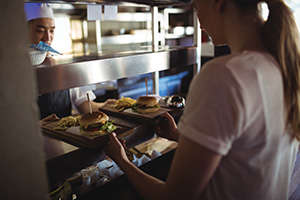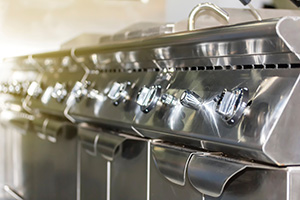5 foodservice trends that will dictate 2019.
By Mark Copeland
In the foodservice industry, competition is everywhere: in the choices people make on where they eat, menu offerings that cater to their preferences and technology used to shop, order and pick up their food.
Research shows more than 5 million people work in the foodservice industry, and while not all companies are in direct competition with one another, the actions they take impact the market and shift the balance of future competition.
Surviving and thriving in this market requires recognizing the latest trends as they strike or steering the market yourself. In a market where competition is everywhere, staying ahead is king.
Trend 1: Technological
Innovations
Smartphones have opened the world of mobile access, yet not all technology is customer focused. Smart technology innovations are making headway in the back of house to simplify processes, exceed previous expectations and improve workplace safety.
- Total Back-of-House Management
 Orders are placed, kitchen staff are alerted to new orders via the kitchen’s management software, and orders are displayed through interactive touch screens. Staff immediately begins to prioritize execution steps based on prep requirements and cooking time to ensure food is completed simultaneously and the system alerts front-of-house staff when orders are ready.
Orders are placed, kitchen staff are alerted to new orders via the kitchen’s management software, and orders are displayed through interactive touch screens. Staff immediately begins to prioritize execution steps based on prep requirements and cooking time to ensure food is completed simultaneously and the system alerts front-of-house staff when orders are ready.
- Smart Technology
Kitchen appliances supporting the cooking process now further those efforts by speaking to one another. The smart refrigerator has a detailed record of its inventory based on a bar code and uses this information to communicate to the grill the exact weight of the steak about to be placed on it. Smart fryers beep when they’re finished, and the smart oven guides staff through preparing each dish perfectly.
- Ongoing Observation
Chefs and managers access analytics provided by systems to monitor inventory, waste and operational efficiency across units, allowing them to correct problems before they grow.
- Continued Cleaning Support
As grease accumulates in the kitchen, an automated hood and flue cleaning system activates multiple times a day to scour areas with powerful cleaning solution. This reduces fire risk and cleans necessary areas without external services or additional staff time — thus reducing labor expenses.
Trend 2: Safer Work Environments
The foodservice industry has a distinguishable, negative record when it comes to employee safety. According to the National Safety Council, more than 25,000 slips and falls occur every day, and cuts, sprains and burns make up the most common types of injury in foodservice.
Only 2% of accidents qualify as severe, but those that do come with a claim cost of $100,000 or more.
In an industry with more than 14 million employees, emphasizing safety is paramount to protect the provider’s bottom line and to care for employees and safeguard morale. Many of today’s top kitchens are using technological advancements for the following benefits:
Training Success Guidelines
- Establish procedures.
- Avoid rushing employees into unprepared roles.
- Provide ongoing support with retraining/new training opportunities.
- Remember every dollar spent on safety training saves $4 to $6 in costs associated with accidents.
Prevention Guidelines
- Institute mandatory deep-cleaning schedules.
- Allot sufficient time to accomplish tasks so employees aren’t rushed.
- Eliminate blind spots and institute a communication system when moving dangerous materials.
- Make ongoing adjustments to continue improvement after incidents occur.
The Expense of Oil
Sixty percent of workers’ compensation incidents in restaurants are related to handling cooking oil, including burns, slips and falls or back strains.
Our closed-loop oil management system allows employees to safely dispose of used oil and fill the fryer with new oil with the flip of a switch, with no need to carry hot oil again.
An automated oil management solution improves physical security by eliminating the need for employees to travel back and forth to the rendering tank to dispose of oil packaging and waste oil. This practice adds unnecessary risk and leaves the back entrance unsecured as employees haul oil containers and oil to the bins.
Eliminating this process ensures fewer injuries, sick days, workers’ compensation claims, and improved employee retention.
Trend 3: Effective Food Waste Management
As Americans continue to push for more eco-friendly lifestyles and reduce their waste, there’s ample opportunity for foodservice providers to follow suit.
According to a report by ReFED, restaurants generate 11.4 million tons of food waste each year, amounting to roughly $25 billion in wasted funds — a cataclysmic number in an industry with historically narrow margins.
Foodservice providers at the head of this trend recognize that reducing their waste component is not only benefitting their bottom line, it’s a healthy marketing initiative that brings their business in line with the philosophies their customers are passionate about.
Practicing Accountability
Monitor products that generate the most waste or are ordered in overabundance and adjust your menu to limit the waste potential of these products. Educate staff on proper portion control (and enforce it through repeated testing), ensuring product is cycled routinely with a first-in, first-out philosophy.
Creating Adaptability
A menu is a living document, and can be adjusted to account for food waste. Some leftovers may be useful resources for new recipes, be it soups, chili or some other menu options. There is another potential life waiting for these otherwise wasted materials.
Getting Digital
The saying “There’s an app for that” holds true for food waste as well. The app Karma allows restaurants, grocery stores and other foodservice vendors the opportunity to sell their excess food at a reduced price. Customers find real value in this eco-friendly practice, and your company recoups additional revenue instead of sending it all to waste.
 Trend 4: Solving Space Concerns
Trend 4: Solving Space Concerns
While shapes and appearances vary drastically, most foodservice operations share one common trait: the back-of-house is smaller than it used to be.
With the continued push toward increased seating capacity, foodservice kitchens have shrunk in size. Without sacrificing the quality of product or the depth of the menu, many kitchen managers are now getting creative with their space utilization:
- A combi oven can serve just about any role at a reduced size.
- Prep coolers can double-duty with a cutting board on their ledge or a flat top that supports stacking.
- Planetary mixers take up no more space than their conventional brethren but deliver a plethora of options.
- Vertical solutions. Taller tools make use of otherwise wasted space.
- Tighter ordering windows.
- Working with vendors to take in more orders of smaller quantity could help your business open up storage space that can be used for other things.
Trend 5: An Emphasis on Experience
Great food is a selling point for any foodservice establishment, but in the year 2018, consumers expect great food to be partnered with a unique experience. To deliver on this trend takes amazing customer service, of course, but it also requires creativity in the opportunities you offer your guests.
Many new restaurants are becoming more extravagant with theming their establishment. Some invite customers to eat in vehicles, or sit through a mock rainforest storm all in the name of a unique dining experience. Others host opportunities to watch a live knife show or have a hand in choosing your own food beyond the menu.
At the same time, many grocery stores are also expanding on the offerings of their deli to create eating areas where customers can enjoy a bite during a day of shopping.
Others are offering unique benefits to the experience via wine tasting events and other social opportunities. The goal is not only to separate the store from its local competition but to draw its customer base away from big-box chains and online retailers like Amazon.
Capitalizing on These Trends Today
In a market where competition is everywhere, staying ahead is the only way to find growth or survival and keeps your company on point and ahead of the competition.
— Mark Copeland leads marketing and product development for Restaurant Technologies. For more than 15 years Restaurant Technologies has been a leading provider of cooking-oil management and exhaust cleaning solutions helping more than 26,000 foodservice providers operate and grow their business. For more information, visit www.rti-inc.com.
